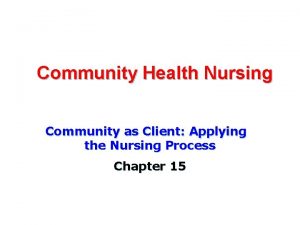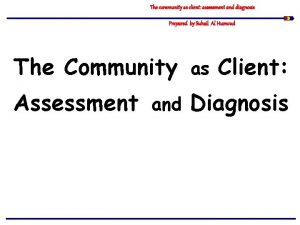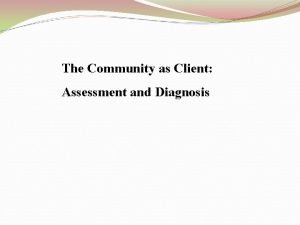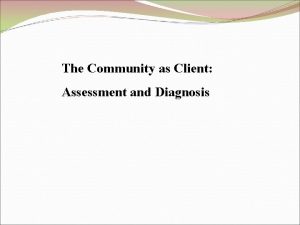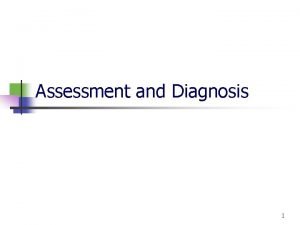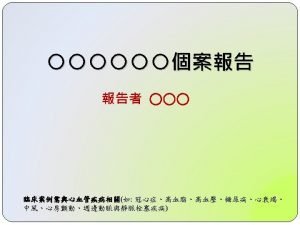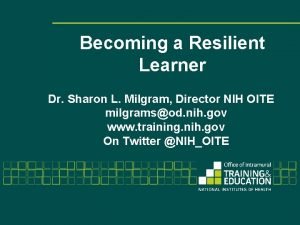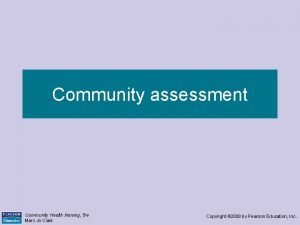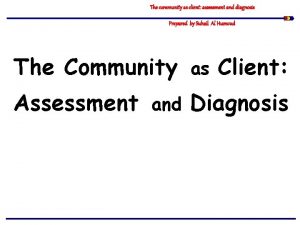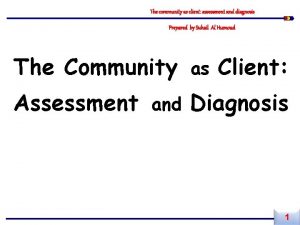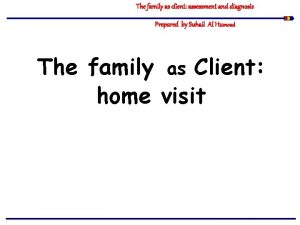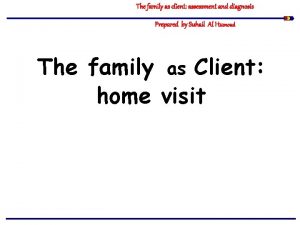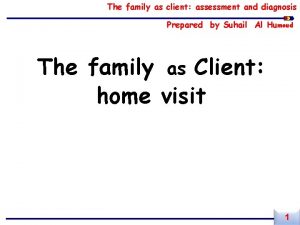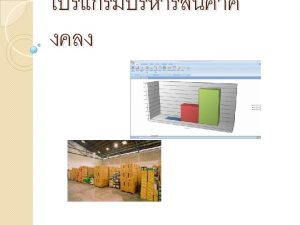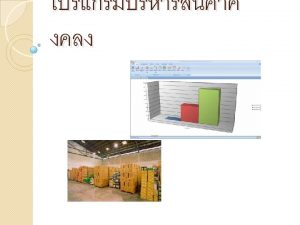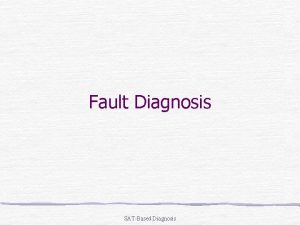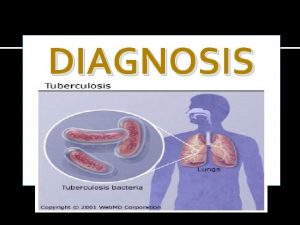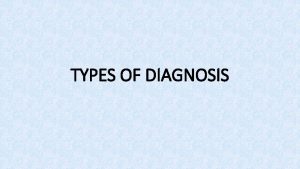The community as client assessment and diagnosis Prepared














































- Slides: 46

The community as client: assessment and diagnosis Prepared by Suhail Al Humoud The Community as Client: Assessment and Diagnosis

The community as client: assessment and diagnosis : objective After completion the lecture the students enable to: ●Describe the meaning of community as client. ● Discuss how a key American value and three myths can undermine a nurses’s intention to move beyond an individualistic focus to practice population-based community health nursing. ● Articulate specific considerations of each of the three dimensions of the community as client. ● Express the meaning and significance of community dynamics. ● Compare and contrast five types of community needs assessment. ● Discuss community needs assessment methods. ● Describe four sources of community data. ● Discuss the significance of formation of community

The community as client: assessment and diagnosis : Introduction Community health nurses work with clients at several levels: as individuals, families, groups, subpopulations, and communities. Table below presents the characteristics of these levels and describes typical nursing involvement at each.

The community as client: assessment and diagnosis : Introduction T A B L E 1 Variations in Scope of Community Health Nursing Practice Client Example Individual Ali X Family Ali family ( seven members Group Parenting group; Al. Anon club Health Characteristics One person with various needs A small group based on kin ties; specific roles Two or more people face-toface communication inter-dependency Nursing Assessment Individual health assessment Family health assessment Assessment of group effectiveness in fulfilling its functions Involvement A dyad; interaction with the individual Family visits; interaction with members as a group Group participation; having a role in meetings

The community as client: assessment and diagnosis : Introduction T A B L E 1 Variations in Scope of Community Health Nursing Practice …cont Client Example Subpop Unmarried ulation pregnant adolescents in a school district Populati on Commu nity Health Characteristics Large group sharing one or more characteristics (subset of a larger group) Nursing Assessment of collective health problems and needs Homeless people An aggregate of people Study of health one or who share needs and vital more personal or statistics environmental characteristics East Harlem, New York City; gay community in the US A large aggregate sharing geographic location or special interests Study of community health characteristic and competence Involvement Study of and planning for meeting specific health needs Membership in organizations such as a health planning council Researching the community; planning and setting up services

The community as client: assessment and diagnosis DIMENSIONS OF THE COMMUNITY AS CLIENT community as having three features: (1) a location, (2) a population, and (3) a social system. This three-dimensional view is especially appropriate for consideration of a local community, which can vary in location if the geographic boundaries are expanded or constricted

DIMENSIONS OF THE COMMUNITY AS CLIENT Location Every physical community carries out its daily existence in a specific geographic location. The health of a community is affected by location, because placement of health services, geographic features, climate, plants, animals, and the humanmade environment are intrinsic to geographic location. The location of a community places it in an environment that offers resources and also poses threats The healthy community is one that makes wise use of its resources and is prepared to meet threats and dangers. In assessing the health of any community, it is necessary to collect information not only about variables specific to location but also about relationships between the community and its location.

DIMENSIONS OF THE COMMUNITY AS CLIENT: location Location There are six location variables: (1)community boundaries, (2) location of health services, (3) geographic features, (4) climate, (5)flora and fauna, and (6) the human-made environment

DIMENSIONS OF THE COMMUNITY AS CLIENT: location (1) Community boundaries serve as basis for measuring incidence of wellness and illness, and for determining spread of disease. Where is the community located? What is its boundary? Is it a part of a larger community? What smaller communities does it include

DIMENSIONS OF THE COMMUNITY AS CLIENT: location (2) location of health services Use of health services depends on availability and accessibility. Where are the major health institutions located? What necessary health institutions are outside the community? Where are they?

DIMENSIONS OF THE COMMUNITY AS CLIENT: location (3) geographic features, Injury, death, and destruction may be caused by floods, earthquakes, volcanoes, tornadoes, or hurricanes. Recreational opportunities at lakes seashore, mountains promote What major landforms are in or near the community? What geographic features pose possible threats? What geographic features offer opportunities for healthful activities?

DIMENSIONS OF THE COMMUNITY AS CLIENT: location (4) climate, Extremes of heat and cold affect health and illness Extremes of temperature and precipitation may tax community’s coping ability. What are the average temperature and precipitation? What are the extremes? What climatic features affect health and fitness ? Is the community prepared to cope with emergencies?

DIMENSIONS OF THE COMMUNITY AS CLIENT: location (5)flora and fauna, and Poisonous plants and disease- carrying animals can affect community health Plants and animals offer resources as well as dangers. What plants and animals pose possible threats to health

DIMENSIONS OF THE COMMUNITY AS CLIENT: location (6) the human-made environment All human influences on environment (housing, dams, farming, type of industry, chemical waste, air pollution, and so forth) can influence levels of community wellness What are the major industries? How have air, land, and water been affected by humans? What is the quality of housing? State health department Do highways allow access to health institutions?

DIMENSIONS OF THE COMMUNITY AS CLIENT: population The health of any community is greatly influenced by the attributes of its population. Various features of the population suggest health needs and provide a basis for health planning A healthy community has leaders who are aware of the population’s characteristics, know its various needs, and respond to those needs. Community health nurses can better understand any community by knowing about its population variables: size, density, composition, rate of growth or decline, cultural characteristics, social class structure, and mobility.

DIMENSIONS OF THE COMMUNITY AS CLIENT: population Population variables: (1) size, (2) density, (3) composition, (4) rate of growth or decline, (5) cultural characteristics, (6) social class structure, and (7) mobility.

DIMENSIONS OF THE COMMUNITY AS CLIENT: population Population variables: (1) size, The number of people influences number and size of health institutions. Size affects homogeneity of the population and its needs What is the population of the community? care community? Census data Is it an urban, suburban, rural community?

DIMENSIONS OF THE COMMUNITY AS CLIENT: population Population variables: (2) Density Increased density may increase stress High and low density often affect the availability of health services What is the density of the population per square mile?

DIMENSIONS OF THE COMMUNITY AS CLIENT: population Population variables: (3) Composition of the population often determines types of health needs. What is the age composition of the community? What is the sex composition of the community? What is the marital status of community members?

DIMENSIONS OF THE COMMUNITY AS CLIENT: population Population variables: (4) Rate of growth or decline Rapidly growing communities may place excessive demands on health services Marked decline in population may signal a poorly functioning community How has population size changed over the past two decades? What are the health implications of this change?

DIMENSIONS OF THE COMMUNITY AS CLIENT: population Population variables: (5) Cultural differences Health needs vary among sub-cultural and ethnic population Utilization of health services varies with culture. Health practices and extent of knowledge are affected by culture. What is the ethnic breakdown of population? What racial groups are represented? What subcultural populations exist in the community? Do any of the subcultural groups have unique health needs and practices? Are different ethnic and cultural groups included in health planning?

DIMENSIONS OF THE COMMUNITY AS CLIENT: population Population variables: (6) Social class Class differences influence the utilization of health services Class composition influences cost of public health services. What percentage of the population falls into each social class? What do class differences suggest for health needs and services?

DIMENSIONS OF THE COMMUNITY AS CLIENT: population Population variables: (7) Mobility of the population affects continuity of care. Mobility affects availability of service to highly mobile populations How frequently do members move into and out of the community? How frequently do members move within the community? Are there any specific populations, such as migrant workers, that are highly mobile? How does the pattern of mobility affect the health of the community? Is the community organized to meet the health needs of mobile groups?

DIMENSIONS OF THE COMMUNITY AS CLIENT: Social System The various parts of a community’s social system that interact and influence the system are called social system variables. Whether assessing a community’s health, developing new services for the mentally ill within the community, or promoting the health of the elderly, the community health nurse needs to understand the community as a social system. A community health nurse working in a small village in SA needs to grasp the social system of that village no less than a nurse working in Capital City.

DIMENSIONS OF THE COMMUNITY AS CLIENT: Social System variables include: Health system Family system Economic system Educational system Religious system Welfare system Political system Recreational system Legal system Communication system Social System

DIMENSIONS OF THE COMMUNITY AS CLIENT: Social System The Concept of a Social System A social system is an abstract concept and can be more readily understood by first considering the people who make up the community’s population. Each person enacts multiple roles, such as parent, spouse, employee, citizen, mosque member, and political volunteer. People in certain roles tend to interact more closely with others in related roles, such as a supervisor with a staff nurse or a customer with a sales Clerk. The various community systems have a profound influence on one another. Because this interaction among parts determines the health of the whole, it is the total social system that concerns community health nurses.

DIMENSIONS OF THE COMMUNITY AS CLIENT: Social System The Health Care Delivery System as Part of the Social System Although community health nurses must examine all the systems in a community and must understand how they interact, the health system is of particular importance. Studying the health system in a community can be compared with assessing an individual client. The major function of the health system is to promote the health of the community. Community assessment asks not merely whether, but also how well, the system is functioning. What is the level of health promotion carried out by the health system of a community?

TYPES OF COMMUNITY NEEDS ASSESSMENT the community health nurse is ready to determine the community’s needs. Assessment is the first step of the nursing process. Assessment for nurses means collecting and evaluating information about a community’s health status to discover existing or potential needs as a basis for planning future action Assessment involves two major activities. The first is collection of pertinent data, and the second is analysis and interpretation of data. These actions overlap and are repeated constantly throughout the assessment. While assessing a community’s ability to enhance its health, the nurse may simultaneously collect data on community lifestyle behaviors and interpret previously collected data on morbidity and mortality.

TYPES OF COMMUNITY NEEDS ASSESSMENT Community needs assessment is the process of determining the real or perceived needs of a defined community. The type of assessment depends on variables such as the needs that exist, the goals to be achieved, and the resources available for carrying out the study. Although it is difficult to determine the type of assessment needed in advance, the decision will be facilitated by understanding several different types of community assessment

TYPES OF COMMUNITY NEEDS ASSESSMENT Familiarization or “Windshield Survey” A familiarization assessment is the most necessary evaluation of a community. Familiarization assessment involves studying data already available on a community, and gathering a certain amount of firsthand data, to gain a working knowledge of the community. Such an approach, sometimes called a “windshield survey, ” is used by nursing students in community assessment courses and by new staff members in community health agencies. Nurses drive (or walk) around the community; find health, social, and governmental services; obtain literature; introduce themselves and explain that they are working in the area; and generally become familiar with the community. This type of assessment is needed whenever the community health nurse works with families, groups, organizations, or populations. Familiarization provides a knowledge of the context in which these aggregates exist

TYPES OF COMMUNITY NEEDS ASSESSMENT problem-oriented assessment, begins with a single problem and assesses the community in terms of that problem. Suppose that Jean, the nurse who explored services available for the Angelo family’s deaf child in Clinical Corner II, had discovered that there were none. Confronted with this problem—one family with one deaf child—she could make a problem-oriented community assessment. Her first step would be to discover the incidence of childhood deafness, both in the community and in the state. The problem-oriented assessment is commonly used when familiarization is not sufficient and a comprehensive assessment is too expensive. This type of assessment is responsive to a particular need. The data collected will be useful in any kind of planning for a community response to the problem.

TYPES OF COMMUNITY NEEDS ASSESSMENT Community Subsystem Assessment In community subsystem assessment, the community health nurse focuses on a single dimension of community life. For example, the nurse might decide to survey churches and religious organizations to discover their roles in the community. What kinds of needs do the leaders in these organizations believe exist? What services do these organizations offer? To what extent are services coordinated within the religious system and between it and other systems in the community? Community subsystem assessment can be a useful way for a team to conduct a more thorough community assessment. If five members of a nursing agency divide up the ten systems in the community and each person does an assessment of two systems, they could then share their findings to create a more comprehensive picture of the community and its needs.

TYPES OF COMMUNITY NEEDS ASSESSMENT Comprehensive Assessment seeks to discover all relevant community health information. It begins with a review of existing studies and all the data presently available on the community. A survey compiles all the demographic information on the population, such as its size, density, and composition. Because comprehensive assessment is an expensive, time-consuming process, it is seldom performed.

TYPES OF COMMUNITY NEEDS ASSESSMENT Community Assets Assessment which focuses on the strengths and capacities of a community rather than its problems. Assets assessment begins with what is present in the community. The capacities and skills of community members are identified, with a focus on creating or rebuilding relationships among local residents, associations, and institutions to multiply power and effectiveness. This approach requires that the assessor look for the positive, or see the glass as “half full. ” The nurse can then become a partner in community intervention efforts, rather than merely a provider of services.

TYPES OF COMMUNITY NEEDS ASSESSMENT Community Assets Assessment Assets assessment has three levels: (1) specific skills, talents, interests, and experiences of individual community members; (2) local citizen associations and organizations; and (3) local institutions. The key, however, is linking these assets together to enhance the community from within.

Community Assessment method COMMUNITY ASSESSMENT METHODS. Community health needs may be assessed by a variety of methods. Regardless of the assessment method used, data must be collected. Data collection in community health requires the exercise of sound professional judgment, effective communication techniques, and special investigative skills. Four important methods are discussed here: surveys, descriptive epidemiologic studies, community forums or town meetings, and focus groups.

Community Assessment method Surveys A survey is an assessment method in which a series of questions is used to collect data for analysis of a specific group or area. Surveys are commonly used to provide a broad range of data that will be helpful when used in conjunction with other sources or if other sources are not available. T

Community Assessment method Descriptive Epidemiologic Studies A second assessment method is a descriptive epidemiologic study, which examines the amount and distribution of a disease or health condition in a population by person (Who is affected? ), by place (Where does the condition occur? ), and by time (When do the cases occur? ). In addition to their value in assessing the health status of a population, descriptive epidemiologic studies are useful for suggesting which individuals are at greatest risk and where and when the condition might occur. They are also useful for health planning purposes and for suggesting hypotheses concerning disease etiology.

Community Assessment method Community Forums or Town Hall Meetings The community forum or town hall meeting is a qualitative assessment method designed to obtain community opinions. It takes place in the neighborhood of the people involved, perhaps in a school gymnasium or an auditorium. The participants are selected to participate by invitation from the group organizing the forum. Members come from within the community and represent all segments of the community that are involved with the issue.

Community Assessment method Focus Groups This fourth assessment method, focus groups, is similar to the community forum or town hall meeting in that it is designed to obtain grassroots opinion. However, it has some differences. First, there is only a small group of participants, usually 5 to 15 people (Polit & Hungler, 2003). The members chosen for the group are homogeneous with respect to specific demographic variables. For example, a focus group may consist of female community health nurses, young women in their first pregnancy,

SOURCES OF COMMUNITY DATA There are many places the community health nurse can look for data to enhance and complete a community assessment. Data sources can be primary or secondary, and they can be from international, state, or local sources.

SOURCES OF COMMUNITY DATA Primary and Secondary Sources Community health nurses make use of many sources in data collection. Community members, including formal leaders, informal leaders, and community inhabitants, can frequently offer the most accurate insights and comprehensive information. Information gathered by talking to people provides primary data, because the data are obtained directly from the community. Secondary sources of data include people who know the community well and the records such people create in the perfomance of their jobs. Specific examples are health team members, client records, community health sta-.

SOURCES OF COMMUNITY DATA Primary and Secondary Sources Secondary sources of data include people who know the community well and the records such people create in the perfomance of their jobs. Specific examples are health team members, client records, community health statistics, Census Bureau data, reference books, research reports, and community health nurses. Because secondary data may not totally describe the community and do not necessarily reflect community self-perceptions, they may need augmentation or further validation

SOURCES OF COMMUNITY DATA International Sources International data are collected by several agencies, including the World Health Organization (WHO) and its six regional offices and health organizations, such as the Pan. American Health Organization. In addition, the United Nations and global specialty organizations that focus on certain populations or health problems, such as the United Nations Children’s Fund, are major sources of international health-related data. WHO publishes an annual report of their activity (World Health Organization, 2003), and international statistics for diseases and illness trends can be found on the Internet.

SOURCES OF COMMUNITY DATA National Sources There are official and nonofficial sources of national data that community health nurses can access if needed. Official sources develop documents based on data compiled by the government.

WHAT IS A HEALTHY COMMUNITY? Because of their complexity, criteria for healthy communities must be discussed cautiously. At present, there is not wide agreement on such criteria, but four important characteristics of a competent or healthy community were outlined by Cottrell (1976) and are still relevant today. A competent community can 1. Collaborate effectively in identifying community needs and problems 2. Achieve a working consensus on goals and priorities 3. Agree on ways and means to implement the agreed-upon goals 4. Collaborate effectively to take the required actions
 Preparatory empathy social work
Preparatory empathy social work Client company name
Client company name What is the nursing process
What is the nursing process Medical diagnosis and nursing diagnosis difference
Medical diagnosis and nursing diagnosis difference Second phase of nursing process
Second phase of nursing process Nursing process and critical thinking
Nursing process and critical thinking Perbedaan diagnosis gizi dan diagnosis medis
Perbedaan diagnosis gizi dan diagnosis medis Thin client vs zero client
Thin client vs zero client Client lourd vs client léger
Client lourd vs client léger Application layer
Application layer Shuster and goeppinger community diagnosis
Shuster and goeppinger community diagnosis List three examples of in-transit foodservice operations
List three examples of in-transit foodservice operations Nursing process conclusion
Nursing process conclusion Define nursing process
Define nursing process Psych nursing care plan examples
Psych nursing care plan examples Community as client
Community as client Community diagnosis
Community diagnosis Community as client
Community as client Community as a client
Community as a client Assessment for diagnosis
Assessment for diagnosis Assessment questions social work
Assessment questions social work Clients needs assessment
Clients needs assessment Biochemical data, medical tests, and procedures (bd)
Biochemical data, medical tests, and procedures (bd) Why is carcase meat prepared into cuts joints and mince
Why is carcase meat prepared into cuts joints and mince The accepted standard of sound and rhythm is
The accepted standard of sound and rhythm is Sharon milgram nih
Sharon milgram nih Anderson and mcfarlane community assessment wheel
Anderson and mcfarlane community assessment wheel Hình ảnh bộ gõ cơ thể búng tay
Hình ảnh bộ gõ cơ thể búng tay Ng-html
Ng-html Bổ thể
Bổ thể Tỉ lệ cơ thể trẻ em
Tỉ lệ cơ thể trẻ em Chó sói
Chó sói Thang điểm glasgow
Thang điểm glasgow Chúa yêu trần thế
Chúa yêu trần thế Các môn thể thao bắt đầu bằng từ đua
Các môn thể thao bắt đầu bằng từ đua Thế nào là hệ số cao nhất
Thế nào là hệ số cao nhất Các châu lục và đại dương trên thế giới
Các châu lục và đại dương trên thế giới Công thức tính độ biến thiên đông lượng
Công thức tính độ biến thiên đông lượng Trời xanh đây là của chúng ta thể thơ
Trời xanh đây là của chúng ta thể thơ Mật thư anh em như thể tay chân
Mật thư anh em như thể tay chân Làm thế nào để 102-1=99
Làm thế nào để 102-1=99 Phản ứng thế ankan
Phản ứng thế ankan Các châu lục và đại dương trên thế giới
Các châu lục và đại dương trên thế giới Thể thơ truyền thống
Thể thơ truyền thống Quá trình desamine hóa có thể tạo ra
Quá trình desamine hóa có thể tạo ra Một số thể thơ truyền thống
Một số thể thơ truyền thống Cái miệng nó xinh thế chỉ nói điều hay thôi
Cái miệng nó xinh thế chỉ nói điều hay thôi










